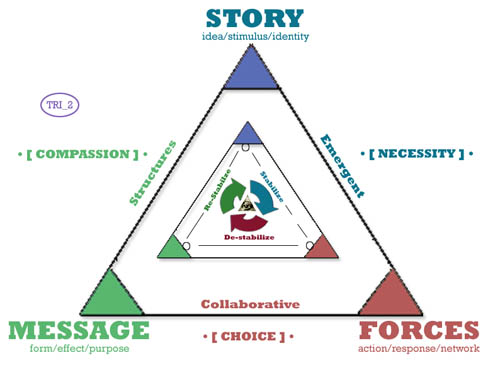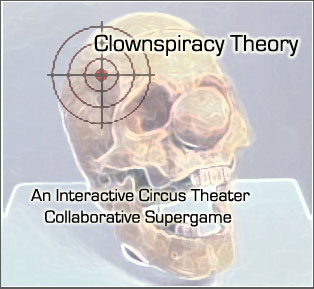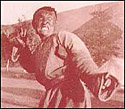An
Introduction
The
way we have "fun" is undergoing big changes. Increasingly,
we are expecting that our "entertainments" will also provide
us with "experiences" that engage us at multiple levels. We
can see evidence of this all around us, as broadcasters, media producers
and concert promoters expand the range of their online and offline offerings
to serve that more active audience that wants to have - at least part
of the time, a more immersive game controller or "first person"-
type experience. In the last ten years since Burning Man (with its "No
Spectators" policy) took root in the desert, the number and size
of U.S. music and "culture" festivals has
grown significantly. Social networks have fundamentally
changed how people play, work and flirt. It used to be that all "scenes"
were local. The Internet, MySpace, IM, Second Life and Massive Multiplayer
Online Games (MMOGs) did away with that limitation. The outer edge of
at least "digital" interactivity today is determined by a
control panel of constraints that each individual is largely free to
set for themselves. This is not to say that people don't still roam
close to home. They do, and here too there are various new tech options
that support increased "localization"
(Google maps mashups, Geo-Caching, Smart Mobs, GPS-triggered media,
Critical Mass, etc.) The box we were supposed to think outside of gets
crushed daily. Equivalencies are getting roughed up.. disorder is rampant..
insurgents from within have hijacked the OS. What we do and how we do
it is moving with greater plasticity than our ability to contain it.
Surrender is the only option left to us. Keeping ourselves surprised
and alive is our new national pastime.
Once
you develop a taste for this type of active participation, it's hard
to return control of your time and choices to someone else, or even
to step back to some less complex level of multi-tasking. Once you have
your own YouTube channel, it's fairly impossible to go back to the way
things were when all you had was the WB, MTV, and Nintendo 64. The whole
entertainment "game" is changing, and so is the target audience
that media and event producers, live performers, game designers and
cellphone service providers are needing to serve.
In what follows, I am going to look at these changes rather specifically
through the lens of "circus/theater" - but
a circus/theater that is anything but a nostalgic throwback. The kind
of circus/theater that makes sense now is one that has broken out from
under the big top altogether. Armed with all sorts of mobile toys and
technologies, this newly liberated clown posse, navigating by the LED
lights of prankster constellations, will run pinball wild across the
web and the world. The death-defying telecircular artists of tomorrow
will be more than just performers of specialty - they will also be hackers
of reality.
Clownspiracy Theory
is
what I call this collaborative project idea intended to get artists
and circusy performers thinking systematically, at the same time it
encourages scientists and social architects to think acrobatically.
To determine whether this species of direction might be of interest
to you (or to someone you know), please explore some or all
of what follows.
 A) An Interactive Theater Production
A) An Interactive Theater Production
Site-specific interactive theater pieces like "Tony and Tina's
Wedding" and "Teatro Zinzanni" have found a permanent
place in the conventional theater/entertainment landscape. As the general
population grows more participatory in their leisure-time preferences,
innovation in such productions is sure to expand and put more commercial
pressure on "old-school" art forms. It is my not terribly
original belief that real-world locations, existing simultaneously in
both actual and virtual realms are a great next stage awaiting experimental
development. Once a location is trackable on a GPS grid, and allows
for easy and accessible wireless connectivity, the field is set for
some new-fangled explorations. Cities like San Francisco are simply
great stages screaming to be populated in this way. And who better to
create just those kinds of next-level "immersive" theatrical
experiences, than our extended alternative art/circus/theater community?
Here is a New
York Times article from 4.22.07, on a new and successful interactive
theater project called "Accomplice: NYC" that's been running
in New York - six months so far.
"It begins with a mobster and
ends with a moll; in between are an assortment of figures, giving a
feel more of a series of random scenes than a unified whole. Unlike
other interactive dramas, which create a contained world like a bar
mitzvah celebration or a wedding, this unpredictable show never presents
a consistent subculture, which may be part of its charm. It has a disorienting
effect that makes you look at the city with skeptical eyes."
As
you read it, picture if you will, a similar (but different)
type of interactive experience - one that uses circus/carny/burlesque
clowns, dancers, musicians, aerialists and acrobats woven into a mystery
storyline all in the service of an evening's traveling entertainment
which might take place in one large facility, in one neighborhood area,
in a wide "game zone" or even in different parts of the city.
(This last option facilitated by cable cars, buses, or other such
vehicles.)
Imagine
the shifting narrative is populated with ghost buffoons, idiot savants,
dark magicians and a chorus line of lethally beautiful burlesque dancers.
Add music - good music; live and pre-recorded - great costumes - dramatic
lighting, large video projections. Throw in some phone calls offering
clues, both internal and external to your current location. Imagine
that audience members are assigned certain secret roles that help turn
the game board of the city into a mysterious circus sideshow for audience
exploration. Make it a mystery - a race to uncover the
Clownspiracy Theory before it discovers and
eliminates you from the competition for top prizes.
 B)
A Mobile Phone & Media "Super" Game B)
A Mobile Phone & Media "Super" Game
Once you
have grasped the notion of next generation interactive theater, then
I'd like to introduce you to the closely related notion of "Supergaming"
or "Alternate
Reality Gaming" (ARG). A really good introduction to "ARG"
can be found in a 4.14.07
SF Weekly cover story on local supergame designer, Jane McGonigal.
"Supergames
slowly reveal a fantasy universe that sends tendrils through both the
virtual and real worlds — mysterious clues and puzzles are revealed
through Web sites, blogs, message boards, voice mails, text messages,
newspaper classified ads, and with strange objects that show up in the
darnedest places. Because the clues are scattered so widely, and because
many of the puzzles and codes are hard to crack, players work together,
setting up forums and wikis to pool their resources and coordinate their
efforts. With thousands of brains linked by new technology, players
become one collective detective, and accomplish remarkable feats."
Imagine
now how the boundaries around such alternative type interactive performance/experiences
as I described above might be expanded to include the use of blogs,
cellphones, GPS, Google map mashups, barcode location tagging, mobile
video combined with a host of analog options like classified ads, signage
and real world clues. As activities of this sort begin to filter up
and into people's entertainment, there seems little doubt that demand
for such experiences will grow, at least to the degree that they can
be orchestrated in ways that engages and recruits participants in "co-creating"
these experiences.
FYI, there's
also an interesting company in NYC called "area/code"
that has had success developing large-scale "commercial" real-world
games as well. An earlier company called Dodgeball,
which offers a location-based mobile app for finding friends, is now
owned by Google. There is also a European group called Reality
Hacking, that has been for 11 years now been executing sophisticated
pranks and provovcations.
 C) A Generative Audio/Video Media Project
C) A Generative Audio/Video Media Project
Putting the two above ideas together, there is little to prevent
the extension of the "event" in a variety of other media &
performance directions. Once you add audio and music (live, pre-recorded,
car stereos, radio broadcasts) as well as still and moving visuals that
both document the action within the show, or let the audience themselves
upload stills or video, the result is a rapidly growing pool of media
assets. Release the music to the show as a CD, create a DVD, or even
drop it into a game shell that re-purposes online media resources and
allows people to re-enact the game/performance on-demand. Build out
a website that engages the audience before and after the event, and
that also offers special
identifying ringtones, GPS instructions, mobile blogs to help carry
the game back into ordinary reality. The online networking and compositional
tools that enable such self-generating development are readily available
and largely free of cost. It is lack of imagination really that is the
biggest obstacle. Pound out new variations. Assign the audience a set
of interlocking secret roles and watch as the neighborhood game zone
becomes a circus ring and sideshow for audience exploration. Google
maps is there for the using to turn your city into a interactive directional
game-map. Along the way, keep the experience tight and action-driven..
throw constant challenges at the audience. Keep it all a mystery though
- a race to unmask the perpetrators, to find the critical keys that
unlock the identity of the mad demigods behind this Clownspiracy
Theory,
before they unmask you.
 D) A Collaborative Community Initiative.
D) A Collaborative Community Initiative.
Clownspiracy Theory follows from
a longer-standing
agenda on my part to explore the ways of collective
action and improvisation
as they apply to artist, audience and community interactions. Those
of us who have spent our lives working collaboratively (as I did
for 20 years in the theater) know that few things are more satisfying
for both performers and
audience than an effective and well-balanced "ensemble experience."
What improvisors
and artist collaborators have known for years is now being experienced
by an increasingly participatory general culture caught up by "Web
2.0"-type technology advances (cell phones, mobile computing, social
networks, multi-player gaming), all of which serve to raise their collective
and interactive quotient to where it is today, sliding right up and
over several proverbial "tipping points" and into a whole
new world of "gaming" and "social play."
As I see
it, it is time to blast some of the more phenomenal talent "emerging"
from our own local San Fran-freako eco-system out and into the larger
art, network, business and technology spheres. Sustainability for the
future of our mad web of interconnected dreams rests largely in our
own hands.
The immediate challenge as I see it, is to move towards the drafting
of any relevant set of stronger and more production-ready collaborative
game scenarios. At the least, these might well be usable and fundable
within the Anon Salon frame
of Sea of Dreams NYE. But
beyond that, why not useable by an idea-hungry mobile technology and
multiplayer gaming industry? Why not usable by loosely conjoined teams
of artists in pursuit of multiple media-driven agendas? Why not useable
as the nimble basis for a whole series of alternate reality games?
Look around. Changes are happening at a dizzying pace. Second
Life is off to the races with its internal streaming audio and video
capacities. Massive and less warlike collaborative online game-worlds
like Will Wright's Spore
are nearing launch. Social networks are beginning to spill over their
garden walls and into web-based virtual worlds. GPS
cellphones, equipped with motion-sensitive
controllers, will allow audio and video to be streamed to you based
on your location and willingness to receive it. Or upload your own cellphone
audio, stills or video to your own channel for instant playback by other
remote "players" Simply put, the real world and the virtual
world are fusing into monumental real-world mashups. It won't be long
before you too will be using Google maps or street
views to zoom into some real-world "gameboard." Such technology
may serve to further abstract your world on one hand, but isn't that
what technology in art have always done? Isn't it really all about play
and pushing for greater transparency with our tools, and about extending
the reach of our physical actions so that they lend greater meaning,
complexity and pleasure to our lives?
As "circus" people, we know something about physical life
- about facing off with gravity, about the inescapable pulse of energy
and the giving over to acts of daring. The laws of the circus teach
us that art is sustained by teams of people, who reliant upon talent
and trust, work together to build the kinds of energetic short-term
collaboration models that make brilliant and practical long-term sense.

***
One of Spoon's
Numerous (and Numinous) Trigrammatical Models
|
|
Obviously,
I wouldn't be putting this out there, if I wasn't looking for feedback.
Thanks,
- spoon <spoon@well.com>
415-381-5622/ 415-608-8455 (c)
"Example
is not the main thing in influencing people, it is the only thing."
- Albert Schweitzer
External
Links:
•
Spoon Links (Sounds Aboundz)- http://telecircus.com/links/
•
Spoon Blogs: Telecircus: http://telecircus.blogspot.com
•
Technologies of Cooperation Map (Institute for the Future)- http://www.rheingold.com/cooperation/Tech_of_cooperation_map.jpg
|



